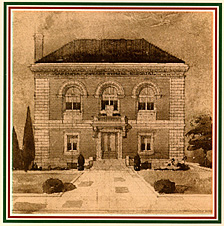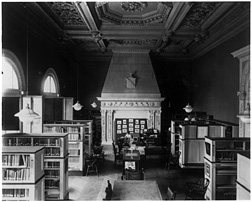
Vol. 23, No.1/Fall 2000

Vol. 23, No.1/Fall 2000
|
 The original National Geographic Society building, circa 1900. The
Library eventually took up the whole top floor.
The original National Geographic Society building, circa 1900. The
Library eventually took up the whole top floor.
A look at the National Geographic Society Library When you think of "National Geographic," do you think of attics full of the famous yellow-bordered magazine? Do you see a TV screen in your mind and hear that trumpet theme, "da da da DAAA da?" How about Alex Trebek and the National Geography Bee? A web site with downloadable maps and interactive features? Classroom teachers learning to teach geography? A new glossy magazine all about adventure? A daily news show? A daily news show?? The National Geographic Society Library supports all of these ventures, and more. The daily show, "National Geographic Today," will air when the new domestic National Geographic Channel premieres on cable in January 2001. It joins the International Channel, Explorer Television, maps, globes, National Geographic magazine, Traveler magazine, Adventure magazine, the children's magazine World, hundreds of books published under our label, the National Geographic web site (www.nationalgeographic.com) and a variety of games and educational software. The Library has had to reshape itself as the Society has changed from a place where it was normal to take three years to properly research, write and photograph a complex story to a place where daily deadlines are a fact of life. Now the business divisions rely on the Library for market research information as much as the editorial divisions rely on us for content on the rain forest. 
The National Geographic Society was founded in 1888, and its first formal Library area was created in 1903. Beginning in 1918, the Library moved from being a members' reading room toward becoming a real research collection when General A.W. Greely - one of the National Geographic Society founders - donated his private polar collection of 1,600 volumes to the Society. From its founding until the 1980s, the chief finding tool in the Library was its catalog and a large world globe. Books were arranged as nearly as possible in the positions of the countries on the map - the Polar Regions in the far north and south of the room; Europe, Asia and Africa on the east side; North and South America on the west side. You had to know your geography to find anything. By 1950, the Library was adding more than 1,000 volumes annually to meet staff research needs and the pace accelerated as the Society began publishing books and filmstrips and producing television programs. When News Division Roll of Honor winner Virginia Carter Hills retired in 1983 she left a staff that had grown to 29 (eight of whom were part of the Clipping Service), a collection of 75,000 volumes and nearly 100 five-drawer file cabinets of clippings. In the 1980s, the geographical classification system was abandoned for the Library of Congress system (reclassification would continue for 16 years) and the Library started drastic weeding programs. The Clipping Service, renamed the News Collection, began to computerize its subject headings. The Library automated acquisitions, cataloging, circulation and the public access catalog using mainframe terminals. Later, the Library switched to client/server technology and an internal network to deliver library catalog service to users' desktops. In the 1990s, the list of Society products and efforts continued to expand. At the same time, pressure to reduce staff and budgets increased, and over the decade - as research time became more precious and deadlines tightened - the Library staff was reduced to 13 and the collection was weeded to 50,000 volumes. Since then, the Library staff has increased with the addition of a Business Research Unit. The current Library staff has 16 people, eight of whom are professional librarians. The Library, seen as an internal leader and consultant in information management, drew on its experience in electronic publishing to support other divisions as they automated. The Library created the first web site on our network in practically a bootleg operation with no budget. This site influenced the creation of the Society's intranet with Library staff leadership. Now the Library has two front doors, one cherry wood and the other digital: our home page on our internal network.
The Library's mandate is to coach and train users to do as much for themselves as possible and to see to it that they have the resources to do their work. The original focus on editorial content has broadened to support the business side and we work closely with Market Research and other business divisions. At the request of the business divisions, two business librarians were added, bringing the total Library staff up to 15. A daily competitive intelligence report is compiled and posted to the intranet. Users can search the Library's catalog or link to other internal databases. Access for all Society staff is provided to a variety of commercial databases including Dow Jones, FirstSearch, Periodicals Abstracts, Community of Science, Books in Print, Hoover's and more. The Library staff still searches the more expensive and less used databases on demand, including Lexis-Nexis, Dialog, Dun & Bradstreet and Westlaw. The Library staff provides training in web research as well as other research skills and coordinates classes taught by various Society staff on business skills like negotiating contracts and editorial skills in geography. The staff shares its expertise by either chairing or participating in cross-divisional efforts toward digital asset management, knowledge management, geo-referencing of assets and creation of an extranet. The three people on the News Collection staff (Nancie Majkowski, Suzan Eaton and Carrie Moy, along with unit manager Ellie Briscoe) all work in other sections of the Library as well; the full-time staff equivalent who clip, file and do reference is about two. We clip from newspapers and magazines in support of the graphical nature of the Society's products. Users love being able to quickly scan decades of past history on a given topic, complete with pictures. The 31,000 files of the News Collection are composed primarily of articles clipped from major U.S. and British newspapers, mostly dating from the 1980s, but some going back to the 1930s. The papers clipped each day include the New York Times, Washington Post, Wall Street Journal, Christian Science Monitor, Los Angeles Times, Washington Times and the Financial Times of London. File copies of USA Today and the Baltimore Sun are available.
Most maps and all photographs, film and video are managed by entirely separate divisions - the Image Collection, which also handles sales of photographs; the Map Library; and the National Geographic Television Archive. The Indexing Division, which Susan Fifer Canby also manages but which is a separate division, produces the Index to National Geographic Publications. All 113 years of the National Geographic Magazine are indexed (as well as other publications) and are available at www.nationalgeographic.com/publications. Ellie Briscoe is Assistant Director, Library and Susan Fifer Canby is Director, Libraries and Indexing at the National Geographic Society. |
News Library News
SLA News Division Home
The page was reformatted on 4/8/03. The content, including URLs and contact information, on this page has not been updated to preserve the historical record.
Comments about News Library News should go to the editor.
Comments about the Web site should go to the Webmaster: newsdivisionweb@yahoo.com